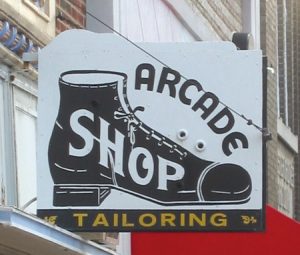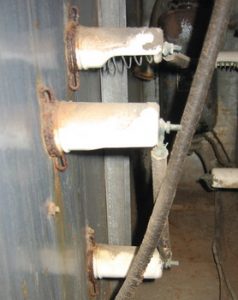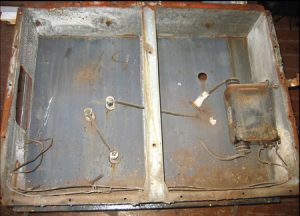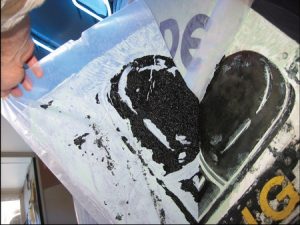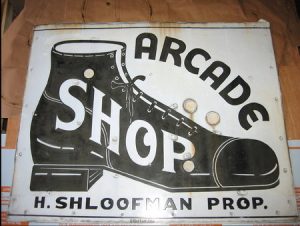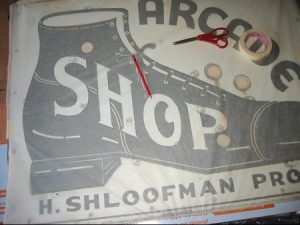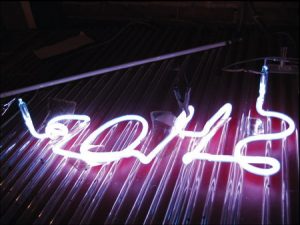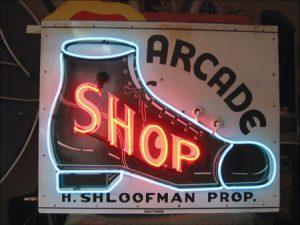LEDs + Lighting
A Neon Rebirth
St. Louis based Neon Time refurbishes a 70-year-old sign.
Published
17 years agoon
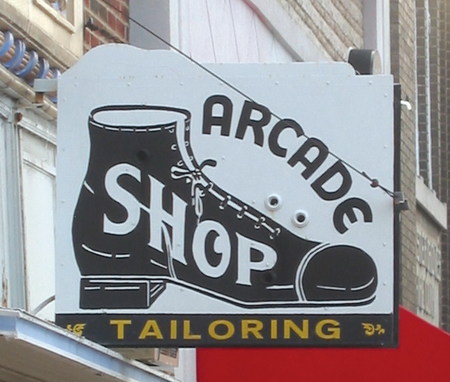
Because neon signs’ business-district presence continually diminishes, movement continues to preserve and restore these signs, which were once everyday landmarks.
In the world of neon-sign preservation, two diverse approaches help acquire vintage neon signs. The first approach focuses on recognizable “standards,” nostalgic stock signs that were distributed to promote petroleum products, beverages and appliances, among others. The second preserves signs unique to a local community and, when possible, leaves them on the streets they’ve occupied for decades.
Whereas the first approach likely yields the most pieces for an enthusiast, preservation is my background. I save signs to which I relate, those that tell the stories I know and inform my history. Restoring signs fortunate enough to remain within their native architecture – whose owners have made the commitment to preserve and maintain them – is a very satisfying endeavor. I enjoy this because more people will enjoy the design’s original aesthetics, notice the craftsmanship and appreciate the remaining nostalgia.
Neon laid bare
Our subject, a unique and reasonably sized sign, dates to 1935. It hung in front of a cobbler’s shop in Webster Groves, an old St. Louis suburb. Though this sign will never go back to the street where it stood for more than 70 years, I approached its restoration as if it would.
AdvertisementI strive to restore something altered, and partially obliterated over the years, to its original, carefully crafted appearance, without complete renewal. I let the patina of its age be revealed while making it functional and brilliant again. Rarely is there justification to make an old sign look brand new. When that’s done, almost all intrinsic value is lost.
When I removed the sign in October 2006, the neon had been defunct for at least 30 years, perhaps 50. The original, porcelain panels have been recently painted over, presumably to disguise decades of weathering. Interestingly, the painter replicated the porcelain’s original details and, fortunately, the original porcelain housings were left in place.
When a defunct porcelain-neon sign is repainted, the housings are commonly knocked out, and the resulting holes are taped over before coating the entire sign with paint. In this case, the neon-tube supports were merely snapped off at their base, and the remaining stubs were painted with the rest of the sign. Curiously, underneath the paint, the porcelain’s surface revealed buried text beneath cut vinyl that read, “Tailoring.”
Wire to wire
Amazingly, a first look inside the sign’s cabinet indicated unadulterated, original wiring, a single transformer and porcelain housings. One had been broken, presumably in a long-ago ice storm. Dirt and debris also remained. Little evidence suggested tampering, rewiring or transformer replacement. Often, frequently serviced signs have open access panels that become havens for large bird nests, debris and heavy deterioration from retained water.
AdvertisementPrior to stripping the coated faces, we carefully removed all the brass screws and nuts, as well as the housings. We discarded the obsolete, high-voltage wiring with a woven covering. Removing all hardware also allowed me to completely strip off the paint without obstructions. I removed one side of the double-faced sign for cleaning and rewiring, which also allowed transformer removal. I tried to retain as much original material as possible.
Delicate refacing
Because we couldn’t determine the porcelain finish’s condition, we brushed a longer-acting, less-caustic stripper on both signfaces. Covering the stripper coating with wax paper keeps it from drying out and helps maintain its effectiveness. When pulled away sometime later, it lifts the paint away, which creates a reverse image. This stripper was less effective on durable paint used on the sign.
The porcelain was in fine condition, without pitting or deterioration of the glossy topcoat, and I made another application with a more heavy-duty paint stripper. I knew it wouldn’t affect the oven-fired porcelain finish as it removed the paint. To complete paint removal, I used soft materials and plastic tools to prevent scratching the face. The stripped sign revealed a colorful art deco sunburst at the top, and, at the bottom beneath the vinyl lettering, we found the buried text was the original proprietor’s name.
AdvertisementAfter having removed the paint, I hand-polished the porcelain panel with a liquid rubbing compound to remove weather stains and rust streaks. Cleaning these panels required significant elbow grease. Finally, I polished with a hard wax to recreate its original luster, but not to make it look new. I discourage clearcoating weathered porcelain signs with a lacquer or acrylic spray – if buying from a collector, make sure this hasn’t been done, because it detracts from the original beauty. Though clean and polished after seven decades of service outdoors, and protected by paint for years, the sign’s weathered appearance will authenticate it.
Let there be neon
To recreate the neon, I first determined its likely original design and color. I laid semi-transparent, vellum paper over the signface to pencil-trace the pattern, from which I made the neon pattern in reverse. I painstakingly matched the original signmaker’s detail and employed early neon-bending techniques faithful to the sign’s era.
Early glass design employed nearly as much detail as the porcelain. I detailed the shoe’s heel, toe and sleeve – though this will significantly increase the glass footage. Vintage neon signs often reveal simplified design and simpler outlines, especially when larger signs were created to be seen from further away. Contrastingly, this sign employed more detail and harkens back to enamel designs that predated neon. I prefer these “crossover” signs.
To outline the text and shoe graphic in neon, I carefully transferred the pattern in reverse to fiberglass fabric using a layer of carbon paper between the vellum tracing and fiberglass. Carefully, I made curves using a flexible drafting curve or vinyl hose that matched the glass diameter.
I carefully mapped the neon-housing position, which must be precise for the glass to fit. Therefore, the glass must be made meticulously to match the pattern to fit the housings. No typical, channel-letter glasswork will suffice. With an outline design such as the shoe, the neon outline is closed; the two double-backs near the housing almost touch, although the receptacles themselves are spread apart to maintain proper, electrical-insulation spacing. One end of the outline will employ a “gooseneck” before turning into the housing.
On a bender
Using the flat, fiberglass pattern, I bent neon for both sides. Note the retro-styled, looped “O.” In the traditional bending style, visible neon sections commonly occupy two planes. In recent times, beer-sign fabricators have commonly dipped their neon in blockout paint, which has perpetuated a bending style that situates all visible neon tubing on the same, flat plane. Bent this way, the “O” would instead be closed at the bottom, with two, double-back bends. Any other letter requires a drop-down bend at every turn.
For this restoration, I used clear glass for two reasons. First, it allowed this relatively small sign’s integral, porcelain details to show prominently. Also, phosphor coatings were less common in this era – almost all early neon signs were either red or blue.
Early neon signmakers commonly employed five- or six-point crossfires to make sharp tube bends. This practice could compromise glass’ natural shape when heated and pushed together to gather a thick wall. To replicate this technique safely, I applied extra heat to the sides, which stretched the bend. The result might look sharper, or even bulge, especially at a right angle, compared to modern, rounded bends.
Then, I pumped the individual neon units. We used red for the word “shoe,” and, for the shoe itself, we chose argon with a drop of mercury to yield the soft blue indicative of the era.
Final touches
We removed the PCB-laden, original transformer, which and replaced it with a solid-state unit, to bolster efficiency and make the sign lighter. I cleaned and repaired the springs, and remounted the original housings. I installed a primary toggle switch in the cabinet for convenience and compliance with modern electrical codes. Securely fastened, the new, high-voltage wiring connects between the neon housings. (It’s important not to touch the metal cabinet.) This simple engineering will ensure years of troublefree, silent operation.
We installed the neon with salvaged, vintage tube supports to replace those that snapped off when the sign was painted over. I painted the friction tape I used as blockout to match the sign’s background. For vintage, outdoor signs, this provides longevity that paint alone can’t provide. Brass screws, which match the originals, complete the project.
All things considered, I was extremely pleased with the project. Though many vintage signs have been torn down in the name of progress, I was proud to play a role in upholding this piece of history.
More About David
David Hutson owns and operates St. Louis-based Neon Time. The name references his introduction to neon: rescuing and restoring vintage neon clocks. Beginning at age 15, he spent his afternoons after school observing and envying the skills of a generation of neon tubebenders who still practiced the craft with techniques learned in neon’s heyday.
After a decade touring the globe as a theatrical production manager and lighting designer, he formalized his neon training by studying with Robert Jansen and Lee Champagne at the National Neon Institute before he opened his business in 1998. Hutson said, “Decades of experience with the diverse industry facets have uniquely positioned me to serve the modern sign trade and faithfully restore yesteryear’s classics.” His goals are quality craftsmanship and designs, as well as preserving the rich past and legacy of 20th-century, American neon.
.
SPONSORED VIDEO
Introducing the Sign Industry Podcast
The Sign Industry Podcast is a platform for every sign person out there — from the old-timers who bent neon and hand-lettered boats to those venturing into new technologies — we want to get their stories out for everyone to hear. Come join us and listen to stories, learn tricks or techniques, and get insights of what’s to come. We are the world’s second oldest profession. The folks who started the world’s oldest profession needed a sign.
You may like
Advertisement
Subscribe

Magazine
Get the most important news
and business ideas from Signsofthetimes Magazine.
Advertisement
Most Popular
-

 Photo Gallery4 days ago
Photo Gallery4 days ago30 Snapshots of the 2024 ISA Sign Expo
-

 Tip Sheet2 weeks ago
Tip Sheet2 weeks agoAlways Brand Yourself and Wear Fewer Hats — Two of April’s Sign Tips
-

 Ask Signs of the Times6 days ago
Ask Signs of the Times6 days agoWhy Are Signs from Canva so Overloaded and Similar?
-

 Paula Fargo1 day ago
Paula Fargo1 day ago5 Reasons to Sell a Sign Company Plus 6 Options
-

 Real Deal2 weeks ago
Real Deal2 weeks agoA Woman Sign Company Owner Confronts a Sexist Wholesaler
-

 Benchmarks1 week ago
Benchmarks1 week ago6 Sports Venue Signs Deserving a Standing Ovation
-

 Photo Gallery1 day ago
Photo Gallery1 day ago21 Larry Albright Plasma Globes, Crackle Tubes and More
-

 Women in Signs2 weeks ago
Women in Signs2 weeks ago2024 Women in Signs: Megan Bradley

